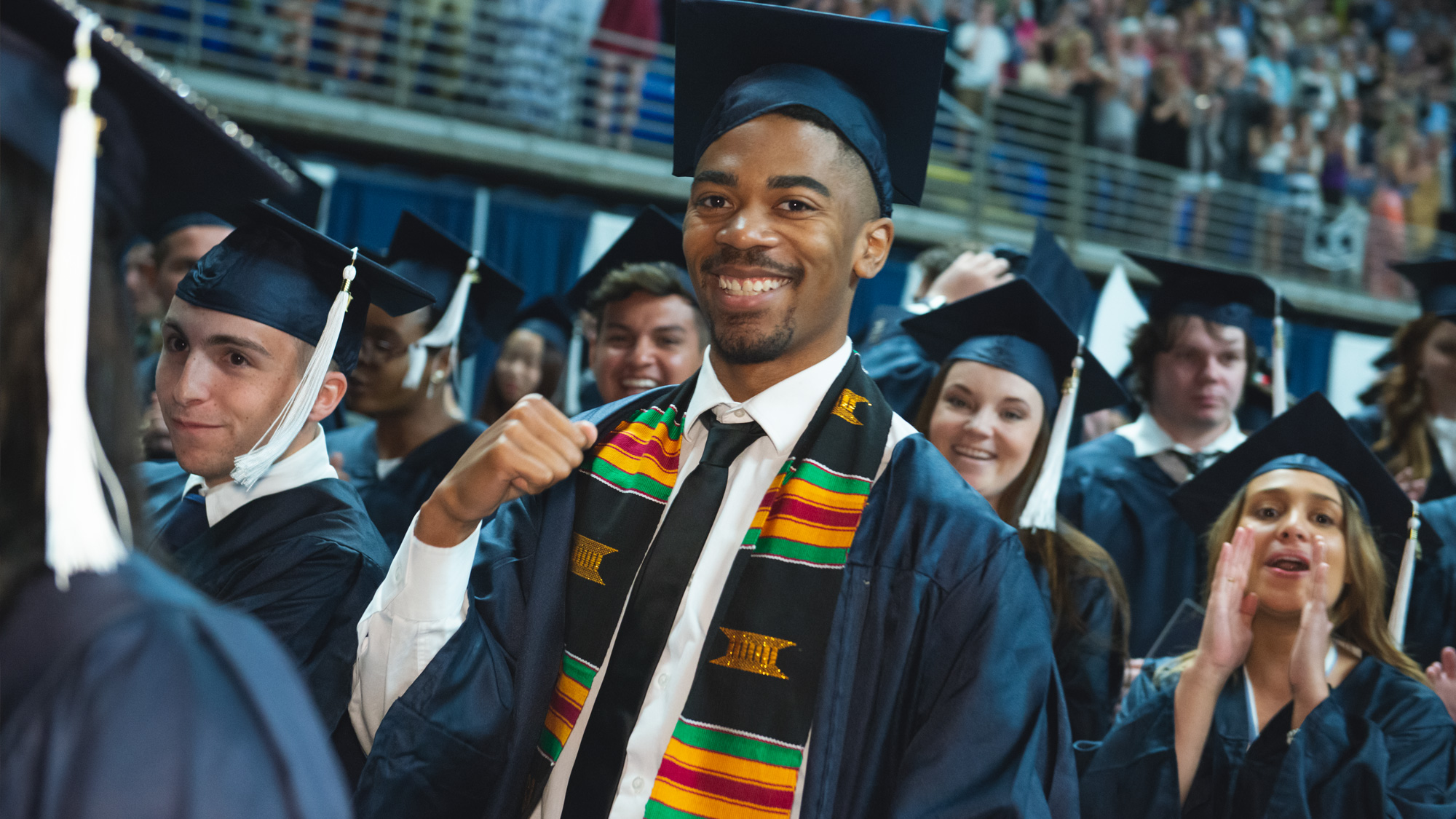100% Online
Complete your Penn State course work at your own pace and 100% online.
Application deadline
Credits and costs
Gain Skills That Can Be Applied across Industries and Professions
Use problem-solving, technical skills, digital tools, and visual communication strategies to design computer graphics and multimedia.
Work in an award-winning virtual space, The Open Studio, using art studio fundamentals.
Build a professional, high-quality digital portfolio showcasing visual art projects, digital art, and web design.
Acquire a practical understanding of the conventions, languages, practices, and aesthetics of digital art and design.
Digital Art Courses in The Open Studio
Digital Art Courses in The Open Studio
This 15-credit program consists of five 3-credit courses, some of which may be used to fulfill other requirements, such as General Education credits in the Arts.
Undergraduate degree students may take ART 10 and ART 20 individually as GA courses.
Prescribed Courses (select 15 credits)
Note: Students must earn a grade of C or better in each course taken to be eligible for the certificate.
- 3credits
Introduction to visual studies; pictorial space and the principles of visual organization.
- or:3credits
Introductory experience in making of art through drawing media; designed for nonmajors seeking general overview of studio practice.
- 3credits
Introduces 2D digital imaging techniques and concepts for the production of original art and design using graphics software.
- or:3credits
Introduces 3D foundational skills for producing images, videos, objects, and interactive real-time virtual spaces with 3D software.
- or:3credits
Introduces time-based animation fundamentals along with core skills and knowledge necessary for producing animated work.
- or:3credits
Introduces essential techniques and concepts of modern web design, focusing on how visual graphics and layout contribute to user experience.
- 3credits
An introduction to the language, aesthetics, and cultural impacts of digital art and design in contemporary society.
- Note
Though ENGL 15 isn't a prerequisite for ART 211Y, this course is writing-intensive and students should be comfortable in their writing before taking the course.
- 3credits
An intermediate level studio course in which students develop digital art and design work that promotes creative thinking and problem-based learning in producing digital media projects to be included in their digital portfolio.
- Prerequisite
DART 202 or DART 203 or DART 204 or DART 205 or DART 206
- 3credits
This course emphasizes the development of presentation skills for digital artists in audience/client interactions.
- Prerequisite
DART 300
Course Availability
If you're ready to see when your courses will be offered, visit our public LionPATH course search (opens in new window) to start planning ahead.
Start or Advance Your Career

Start or Advance Your Career
You can use the knowledge gained from this program and the support of Penn State career resources to pursue careers in a variety of fields or to move on to a bachelor’s degree or associate degree program, depending on your goals.
Career Services to Set You Up for Success

From the day you're accepted as a student, you can access resources and tools provided by Penn State World Campus Career Services to further your career. These resources are beneficial whether you're searching for a job or advancing in an established career.
- Opportunities to connect with employers
- Career counselor/coach support
- Occupation and salary information
- Internships
- Graduate school resources
Job Titles Related to This Degree
This certificate focuses on enhancing creative problem-solving through project-based learning — giving you a very practical, real-world emphasis. As a digital arts professional, you can create digitally based media and computer-based art and designs relevant to many professional and personal interest areas, including:
- computer technologies
- computer graphics
- graphic arts
- education
- corporate communications
- advertising
- original or manipulated photography
- media-rich web productions
- freelance businesses
- consulting
Upcoming Events
Ready to Learn More?
Get the resources you need to make informed decisions about your education. Request information on this program and other programs of interest by completing this form.
Ready to take the next step toward your Penn State undergraduate certificate?
Costs and Financial Aid
Costs and Financial Aid
Learn about this program's tuition, fees, scholarship opportunities, grants, payment options, and military benefits.
Costs and Financial Aid
Undergraduate Tuition
Undergraduate tuition is calculated based on the number of credits for which you register and the number of total credits you have accrued at or transferred to Penn State.
Tuition is due shortly after each semester begins and rates are assessed every semester of enrollment.
2024–25 Academic Year Rates
| How many credits do you plan to take per semester? | If you have 59 or fewer credits | If you have 60 or more credits |
|---|---|---|
| 11 or fewer | $632 per credit | $678 per credit |
| 12–19 | $7,678 per semester | $8,288 per semester |
2025–26 Academic Year Rates
| How many credits do you plan to take per semester? | If you have 59 or fewer credits | If you have 60 or more credits |
|---|---|---|
| 11 or fewer | $638 per credit | $685 per credit |
| 12–19 | $7,755 per semester | $8,371 per semester |
Undergraduate students taking more than 19 credits will be charged the flat tuition rate plus the regular per credit hour rate for each credit above 19.
Paying for Your Certificate
Students pursuing a certificate are considered "nondegree," a status that is not eligible for federal student aid, including the Federal Direct Stafford Loan program. A private alternative loan may be an option to consider.
Additionally, Penn State offers many ways to pay for your education, including an installment plan and third-party payments. Penn State World Campus also offers an Employer Reimbursement and Tuition Deferment Plan. Learn more about the options for paying for your education.
Students pursuing a degree and meeting all other eligibility requirements may qualify for financial aid.
Military Benefits
Military service members, veterans, and their spouses or dependents should explore these potential military education benefits and financial aid opportunities, as well.
Additional Cost of Attendance Details
To view the detailed list of cost of attendance elements:
- visit the Tuition Information site
- click the plus sign to expand the table
- select a semester from the World Campus row
Who Should Apply?
The digital arts certificate is an ideal program if you:
- are interested in computer-based graphics, multimedia, art, digital illustration, or media-rich web design
- want to strengthen your existing skills to support your professional responsibilities
Set Your Own Pace

Set Your Own Pace
Whether you are looking to finish your program as quickly as possible or balance your studies with your busy life, Penn State World Campus can help you achieve your education goals. Many students take one or two courses per semester.
Our online courses typically follow a 12- to 15-week semester cycle, and there are three semesters per year (spring, summer, and fall). If you plan to take a heavy course load, you should expect your course work to be your primary focus and discuss your schedule with your academic adviser.
To Finish Your Certificate in One Year
- Take 2 courses each semester
To Finish Your Certificate in Two Years
- Take 1 course each semester
Timelines may vary based on course availability.
Convenient Online Format
This program's convenient online format gives you the flexibility you need to study around your busy schedule. You can skip the lengthy commute without sacrificing the quality of your education and prepare yourself for more rewarding career opportunities without leaving your home.
A Trusted Leader in Online Education

Penn State has a history of more than 100 years of distance education, and World Campus has been a leader in online learning for more than two decades. Our online learning environment offers the same quality education that our students experience on campus.
How to Apply to Penn State

How to Apply to Penn State
Apply by May 5 to start May 11
Application Instructions
Deadlines and Important Dates
Complete your application and submit all required materials by the appropriate deadline. Your deadline will depend on the semester you plan to start your courses.
Summer Deadline
Apply by May 5 to start May 11Fall Deadline
Apply by August 17 to start August 25Spring Deadline
Apply by December 22, 2025, to start January 12, 2026
Steps to Apply
To apply for this program, you must be a high school graduate, or have completed your GED.
If you are already enrolled in a World Campus degree program, you can complete this certificate along with your degree program. If you are interested in using the digital arts certificate courses to help fulfill the requirements for an associate degree in information sciences and technology, talk to your assigned World Campus academic adviser to learn more.
If you are not enrolled in a World Campus degree program, you may still pursue this certificate as a nondegree student. Students pursuing a stand-alone certificate are classified as nondegree. (Nondegree students do receive full college credit for all courses taken in nondegree status; however, financial aid is not available to nondegree students.)
If you were previously enrolled in this certificate or another program, you may need to submit the Undergraduate Nondegree Enrollment Form instead of the Undergraduate Certificate Application. See if one of the following applies to you and contact us if you need confirmation of the best step to take.
- If you were accepted to this certificate program for a previous semester and wish to continue your studies, please submit the Undergraduate Nondegree Enrollment Form.
- If you have previously been accepted to a different certificate program and you would now like to enroll in this one, you will need to apply for this certificate using the Undergraduate Certificate Application in Step 3.
- If you have been accepted to a degree program and would like to enroll in this certificate, contact your adviser.
3. Complete the application.
Admissions Help
If you have questions about the admissions process, email [email protected] or call 814-865-1146.
Contact Us

Contact Us
Have questions or want more information? We're happy to talk.
To learn more about the Undergraduate Certificate in Digital Arts, please contact:
World Campus Central
Phone: 814-865-1146
[email protected]
Learn from the Best
Learn from the Best
One of the primary reasons Penn State is recognized around the globe as a distinguished university is its faculty. The Undergraduate Certificate in Digital Arts is offered in partnership with the Penn State College of Arts and Architecture, and you will enjoy the opportunity to learn from the same instructors who teach traditional, face-to-face classes on Penn State's campuses across Pennsylvania.
Faculty
Stephen St. Amant
- DegreeM.F.A., Penn State
- DegreeB.F.A., Maryland Institute College of Art (MICA)
Stephen St. Amant, adjunct assistant teaching professor, teaches Introduction to Sculpture. Stephen is an artist, marketer, and musician living in central Pennsylvania. His work is not tied to a specific medium, but woodworking and cabinetmaking have been longtime loves. In his drawings, sculptures, and design work, craftsmanship and attention to detail are a continuous thread. Stephen’s work often uses everyday objects and routines as entry-points to considering larger ideas. Stephen writes a daily blog about productivity, creativity, and personal disposition at www.savenwood.com.
Benjamin Andrew
- DegreeM.F.A., Mount Royal School of Art, Maryland Institute College of Art
- DegreeB.F.A., Painting, Pratt Institute
Benjamin Andrew is an assistant teaching professor at Penn State, specializing in online education and interdisciplinary design. He has worked as a graphic and web designer for clients ranging from political campaigns to research teams at NASA. His fine art practice explores the frontiers of storytelling by leveraging participatory art and digital media to imagine strange new futures. He previously taught at the Maryland Institute College of Art and Johns Hopkins University; though he misses Baltimore, he enjoys his new home on the internet.
Kenneth Ian Brill
- DegreeM.F.A., New Media, Penn State
- DegreeB.A., Studio Arts, University of Pittsburgh
Ian Brill is an instructor of digital art for Penn State World Campus. His work focuses on the accumulation of form through process. Through the design of interactive, performative, and multisensorial environments, he considers boundaries of becoming (versus being) and our immersive relationship with technology. His installations, performances, and writing have been presented internationally at conferences, festivals, and galleries.
Jamie DiSarno
- DegreePh.D., Visual Studies, University of Buffalo
- DegreeM.F.A., New Media, Penn State
- DegreeB.F.A., Painting and Sculpture, State University of New York at Fredonia
Dr. Jamie DiSarno earned a Ph.D. from University of Buffalo in 2020. She teaches digital art practice and theory as well as modern and contemporary art history and visual culture. Dr. DiSarno has presented her research at national and international conferences, including the College Art Association Conference, the Latin American Studies Association Congress, and the Association for Art History Annual Conference. She published in Wanderlust: A History of Walking in 2018. She taught at Rochester Institute of Technology, University of Buffalo, and State University of New York at Fredonia.
Anna Divinsky
- DegreeB.A., Studio Arts, Art History, University of Pittsburgh
- DegreeM.F.A., Printmaking, Penn State
Anna Divinsky is an assistant teaching professor of art at the Penn State College of Arts and Architecture Office of Digital Learning. She is also the digital arts certificate and digital multimedia design program coordinator. Her passion and research focus on exploring best teaching and learning practices in online art education.
As a recent Innovator in Residence grant recipient from the Center for Pedagogy in Arts and Design, Divinsky continues to share best practices in online teaching, assessment, and engagement through the College of Arts and Architecture Graduate Certificate in Online Teaching, fostering a place for growth and community for graduate students within the college. Being an artist inspires and informs Divinsky’s approach to pedagogy, integrating studio techniques, appreciation of detail, love for design, and hands-on art-making.
Inbar Hagai
- DegreeM.F.A., Fine Arts, Carnegie Mellon University
- DegreeB.F.A., Fine Arts, Bezalel Academy of Arts and Design
Inbar Hagai is an adjunct lecturer in the Penn State digital multimedia design program. A multidisciplinary artist, her practice spans video, virtual reality, sculpture, installation, and experimental documentary filmmaking. Hagai earned her B.F.A. with honors from the Bezalel Academy of Arts and Design and her M.F.A. from Carnegie Mellon University. Her works have been exhibited internationally in art institutions as well as film and media festivals.
Megan Handley
- DegreeM.F.A., Graphic Design and Visual Experience, Savannah College of Art & Design
- DegreeB.A., Journalism and English Literature, Northeastern University
Megan Handley is a designer, author, speaker, and educator. She has taught design at the college level for about 15 years. She provides her students with a connected learning environment where they become conceptual and strategic thinkers in current industry practices and technologies. She prides herself on shaping a cohesive learning environment for a diverse, equitable, and inclusive student population. She is also an active designer with a portfolio showcasing two decades of design fluency across media. Her work has been published, exhibited, and given numerous awards.
Eduardo Navas
- DegreePh.D., University of California
- DegreeM.F.A., California Institute of the Arts
- DegreeB.F.A., Otis College of Art and Design
Dr. Eduardo Navas teaches on the principles of cultural analytics and digital humanities in the School of Visual Arts, College of Arts and Architecture, at Penn State, researching the creative and political role of recyclability and remix in art, media, and culture. He has lectured internationally, and he produces art and publishes on remix studies.
Courtney Redding
- DegreeM.F.A., Ceramics, Marywood University
- DegreeB.A., Studio Art, Shippensburg University
Courtney Redding is an adjunct lecturer with the School of Visual Arts and teaches courses in the digital multimedia design program and the digital arts certificate program. Her work encompasses the art and design world, with a focus on multiple media forms of expression. Redding's influences are from a diverse array of disciplines. From science and history to the natural world and technological field, her imagery integrates these backgrounds into a philosophy of symbols and a personal typographic and textural array.
Christine J. Shanks
- DegreeM.F.A., Photography, University of Delaware
- DegreeB.S., Visual Communications, Towson University
Christine J. Shanks teaches and creates work in both traditional studio and digital media. She applies her design background to her multifaceted work in academia by utilizing user-experience principles, creativity, and design thinking in her curriculum and pedagogy. As an educator, her primary goal is to establish a supportive classroom that emboldens students to explore and refine their process, motivations, and skills. She feels her work in academia and design are intertwined; new projects and pursuits in one field develop from ideas and exploration in the other.
